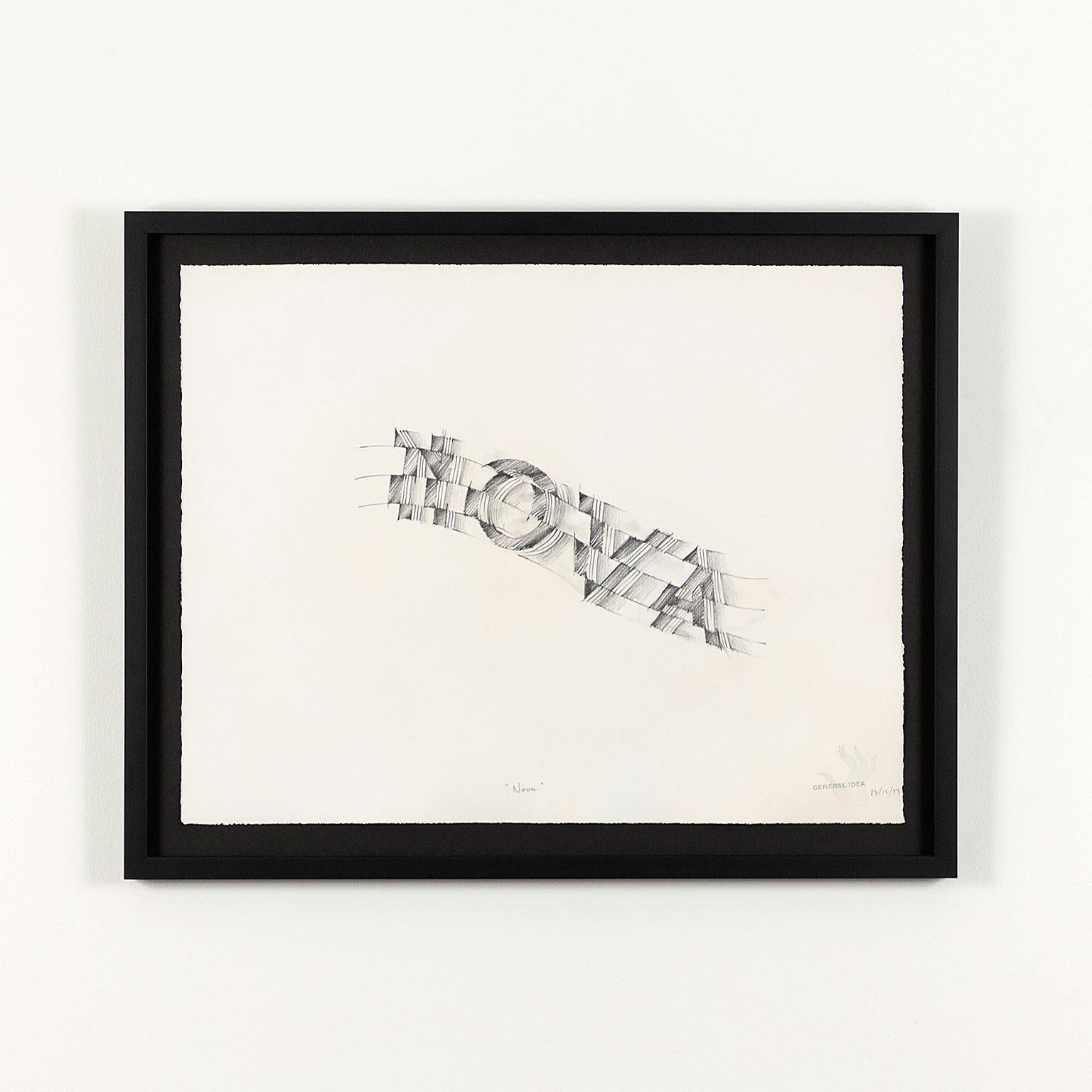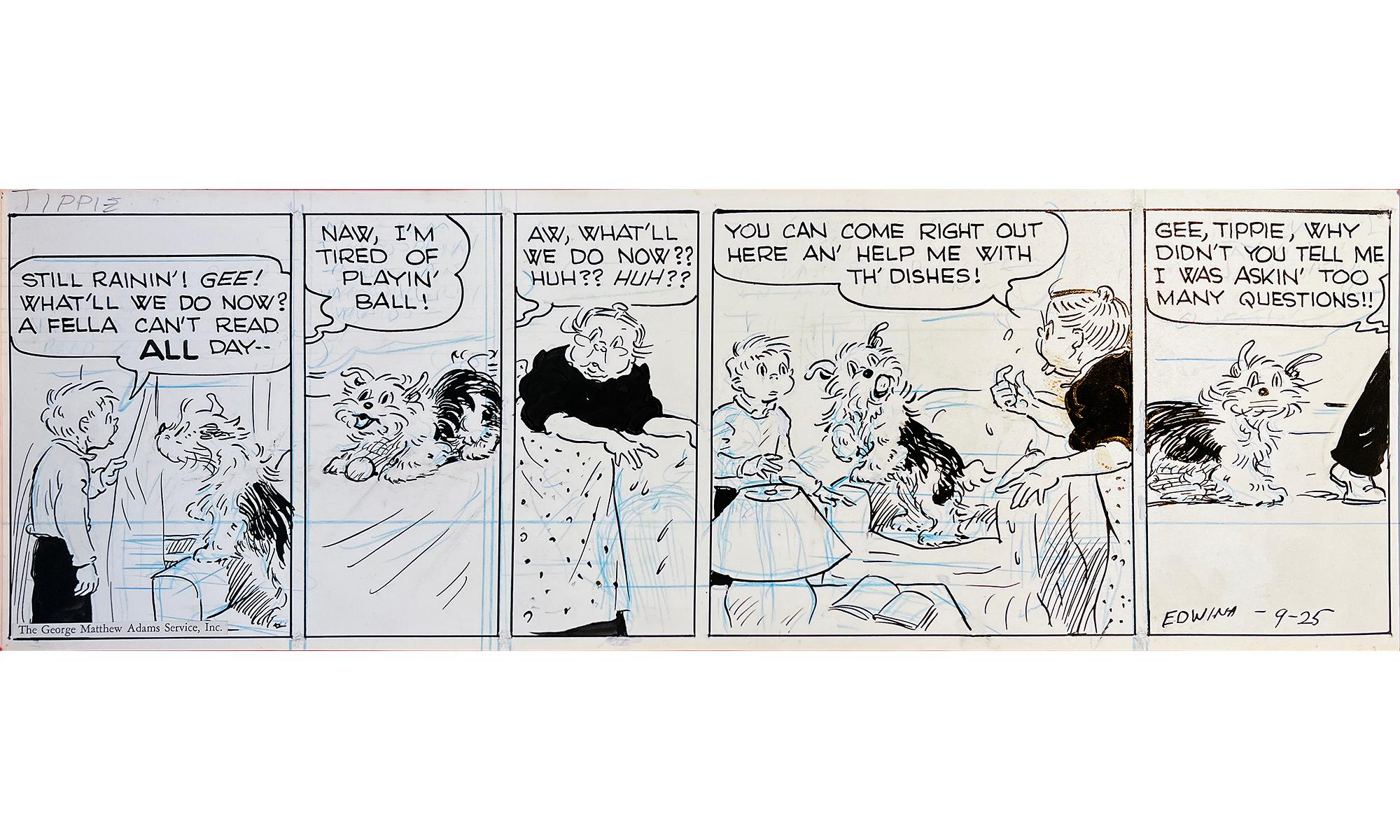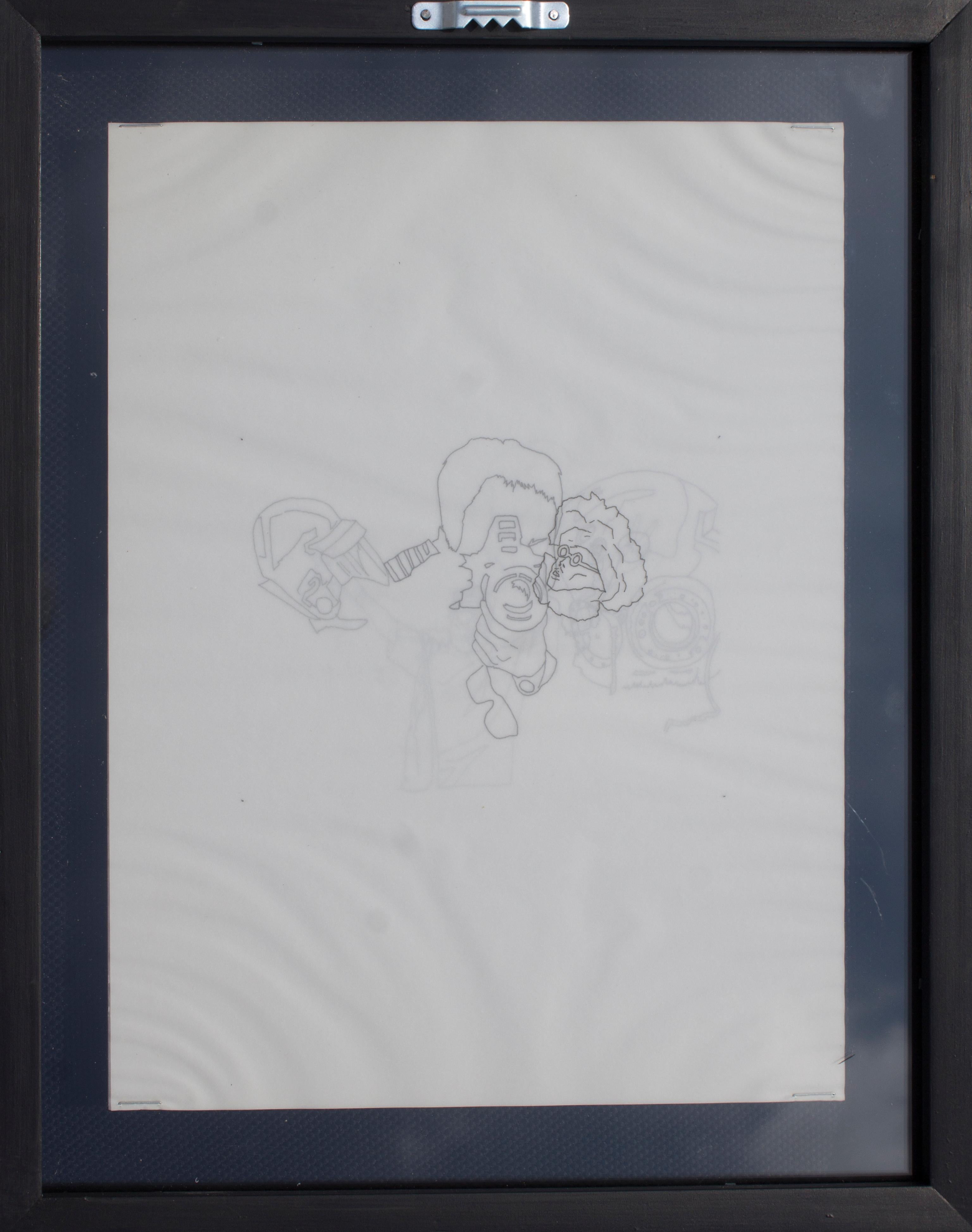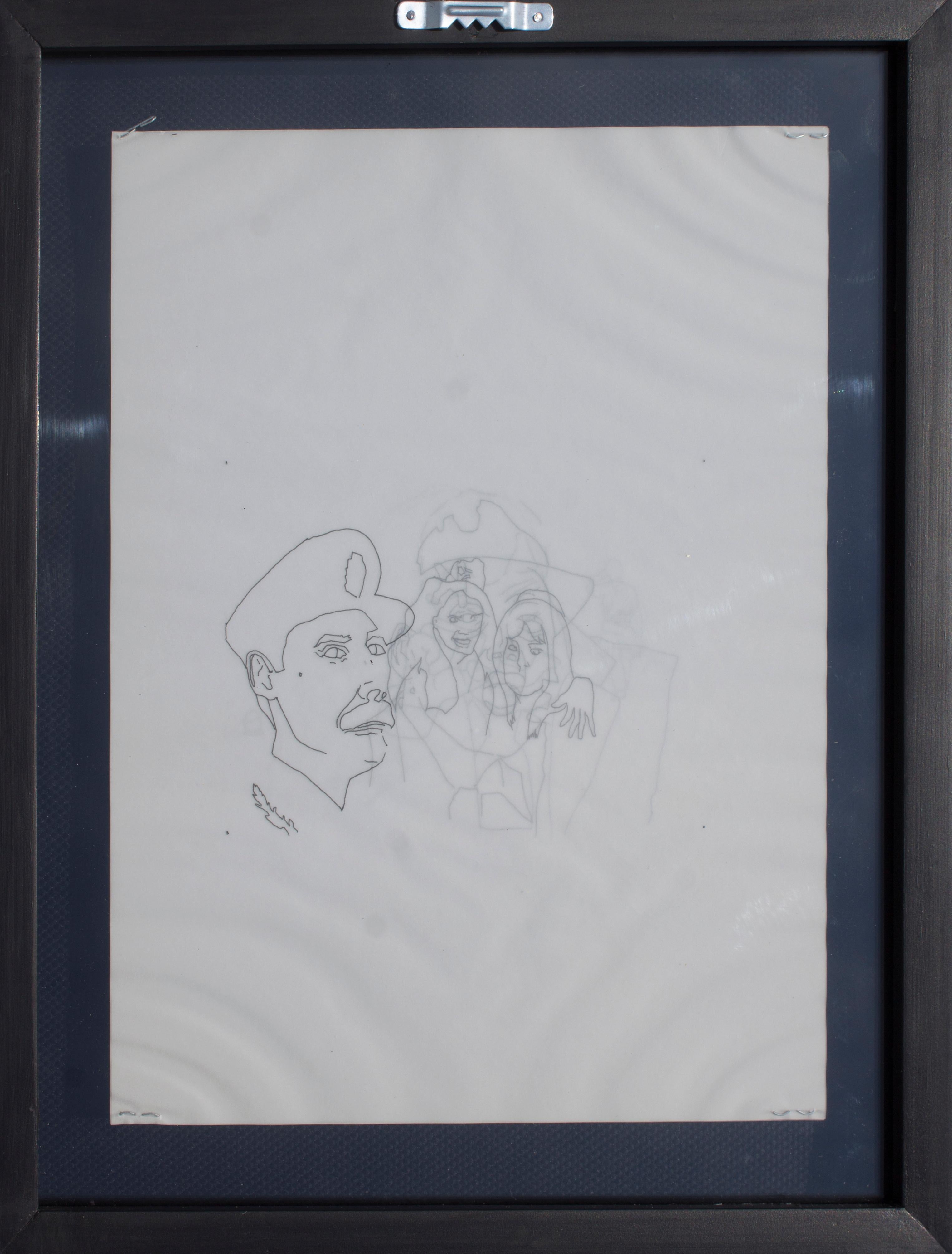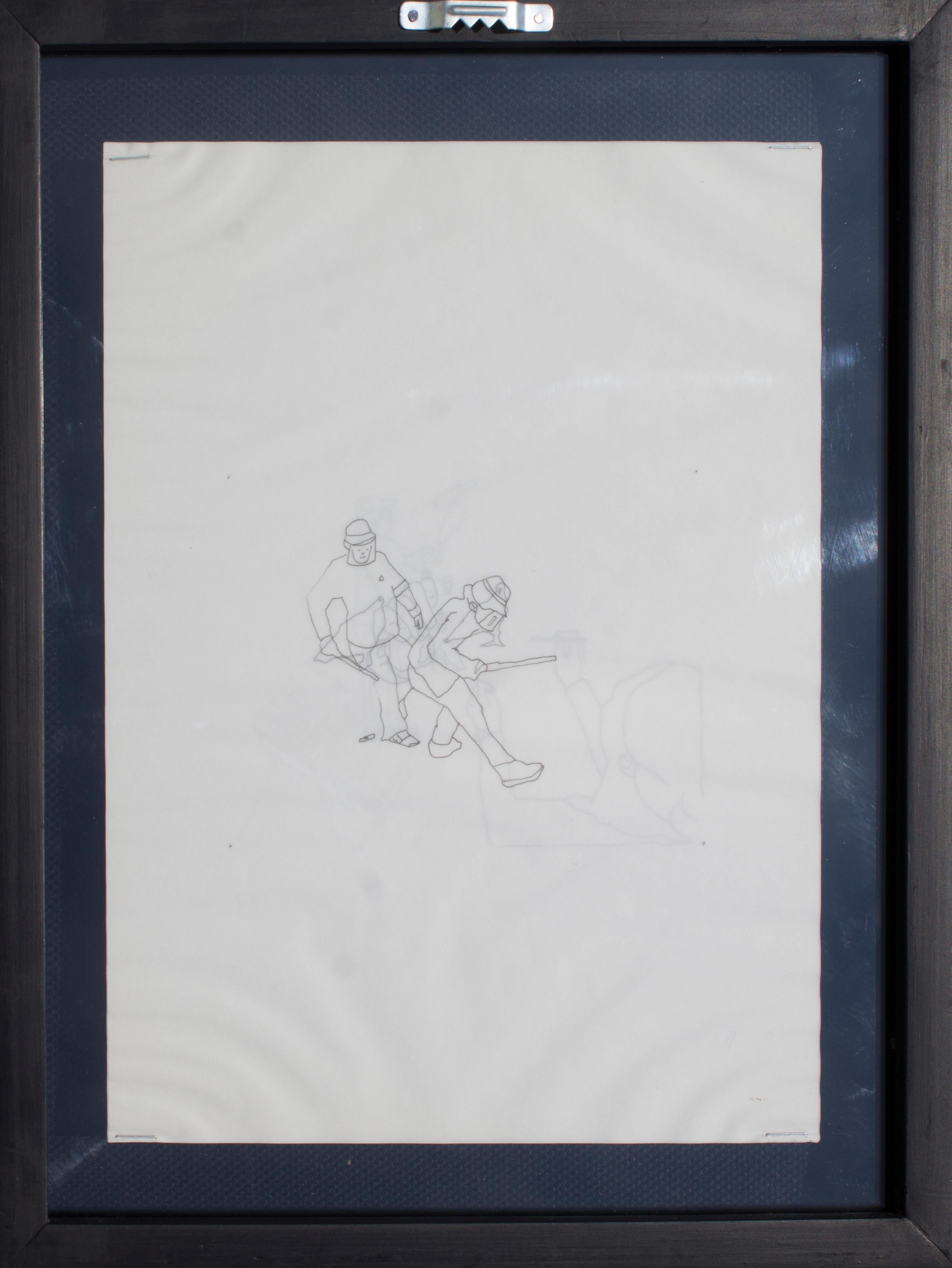Items Similar to Ken Aptekar Contemporary Conceptual Judaica Art Drawing Go Study Chasidic Rabbis
Want more images or videos?
Request additional images or videos from the seller
1 of 7
Ken AptekarKen Aptekar Contemporary Conceptual Judaica Art Drawing Go Study Chasidic Rabbis1996
1996
About the Item
Ken Aptekar
American (b. 1950)
Go Know (Study)
1996
Graphite, white pigment, transparency film, and staples on paper
Hand signed lower right
sheet: 18 x 18 inches
frame dimensions: 21 x 21 x 1 3/4 inches, wood frame with acrylic glazing
Ken Aptekar is an artist who combines painting with text. He paints new versions of historical paintings and frames, bolting glass with sandblasted words to his painted panels. Aptekar’s work belongs to the tradition of painting, yet he brings to that tradition a recognition that paintings produce meaning only through their interaction with viewers. He investigates the nature of spectatorship. By “recreating” works of art in a painterly but utilitarian manner, Aptekar promotes viewers’ own narratives prompted by the image-text combinations.
Born in Detroit, Aptekar received his BFA at the University of Michigan, then moved to Brooklyn to complete an MFA at Pratt Institute. Most recently, his work was featured at the Jewish Museum in Vienna, Austria, and in the Biennale Internationale d’Autun, in Autun, France. A major commissioned solo exhibition, NACHBARN (“NEIGHBORS”), 2016, was on view at the St. Annen Museum in Lübeck, Germany, including paintings with text, silverpoint drawings, and video all based upon medieval altarpieces in the St. Annen Museum’s collection.
Previously, his work has been seen in solo exhibitions at the Victoria & Albert Museum in collaboration with the Serpentine Gallery (London), the Corcoran Gallery of Art (Washington, DC), Memorial Art Gallery (Rochester, NY), Centro da Cultura Judaica (Sao Paolo, Brazil), Musée Robert Dubois-Corneau (Brunoy, France), the New Museum (New York, NY), Douglas Cooley Gallery at Reed College (Portland, OR), Palmer Museum of Art at Penn State (State College, PA), Cummer Museum (Jacksonville, FL), and the Elaine Jacob Gallery at Wayne State University (Detroit, MI). In 2012 Aptekar’s work was the subject of a survey exhibition, “Ken Aptekar: Look Again,” at the Beard and Weil Galleries, Wheaton College, Massachusetts. He was in the show Words & Music
with John Giorno, Cheonae Kim, Ken Aptekar, William Anastasi, Monique Prieto, Jane Callister at Michael Berger Gallery. He was featured in the book Looking Jewish: Visual Culture & Modern Diaspora by Carol Zemel
about artists and cultural figures in interwar Eastern Europe and postwar America who blended Jewishness and mainstream modernism to create a diasporic art, one that transcends dominant national traditions.
Ken Aptekar, Alter Kacyzne, Moshe Vorobeichic, Bruno Schulz, Roman Vishniac and works by R. B. Kitaj, Ben Katchor, and Vera Frenkel that explore Jewish identity in a postmodern environment. A solo exhibition of Ken Aptekar’s was at Wasserman Projects in Detroit in 2024. Aptekar is the recipient of two NEA Fellowships in Painting, a Mid-Atlantic Arts Foundation Award, a Rockefeller Residency at Bellagio, several Djerassi Resident Artist Program awards, and a Jackson Pollock Lee Krasner Foundation Award. He lives with the writer Eunice Lipton and divides his time between Paris and New York.
- Creator:Ken Aptekar (1950, American)
- Creation Year:1996
- Dimensions:Height: 21 in (53.34 cm)Width: 21 in (53.34 cm)
- Medium:
- Movement & Style:
- Period:
- Condition:
- Gallery Location:Surfside, FL
- Reference Number:1stDibs: LU38214305512
About the Seller
4.9
Platinum Seller
These expertly vetted sellers are 1stDibs' most experienced sellers and are rated highest by our customers.
Established in 1995
1stDibs seller since 2014
1,549 sales on 1stDibs
Typical response time: 1 hour
- ShippingRetrieving quote...Ships From: Surfside, FL
- Return PolicyA return for this item may be initiated within 3 days of delivery.
More From This SellerView All
- German Neo Expressionist Graphite Pencil Drawing Erwin Pfrang Nolan Gallery NYCLocated in Surfside, FLErwin Pfrang, German (b. 1951) Graphite Pencil on paper Framed 20 X 20.5, sheet 12.5 X 13 Hand signed lower left Erwin Pfrang (born 1951, in Munich) is a German painter and printmaker. Pfrang studied at the Academy of Fine Arts in Munich from 1974–79. Later he spent many years as an independent artist in Montepulciano, Val d’Orcia and Catania, Italy, interrupted by stays in Munich and Augsburg. He presently lives and works in Berlin. Erwin Pfrang is the grandson of the Munich folk comedian Konstantin Pfrang. Carla Schulz-Hoffmann makes an attempt at characterising the painter: “An artist such as Erwin Pfrang inhabits an alternative world, a tiny microcosm of subjectivity, and lives that life uncompromisingly, with all the limitations and hardships that it entails. Among twentieth-century artists a comparable stance can be encountered perhaps in Jean Fautrier, but certainly in Otto Wols. His oeuvre relates in its figuration to Bosch or James Ensor and his oil painting to Lucian Freud in its painterly quality. Erwin Pfrang is represented by gallerists Fred Jahn, Munich (Exhibition: Don’t Forget Your Mask: Don’t (Part I: Don’t Forget Your Mask), Forget (Part II: Don’t Forget Your Mask), Your Mask (Part III: Don’t Forget Your Mask)Artists: Imi Knoebel, Barry Le Va, Karel Appel, Alexi Tsioris, William N. Copley, Isa Genzken...Category
Early 2000s Neo-Expressionist Figurative Drawings and Watercolors
MaterialsPaper, Pencil, Graphite
- German Neo Expressionist Graphite Drawing Erwin Pfrang Nolan Eckman Gallery NYCLocated in Surfside, FLErwin Pfrang, German (b. 1951) Graphite on paper Partner Exchange (2001) Framed 21 X 14.5 sheet 13.75 X 7.25 Erwin Pfrang (born 1951, in Munich) is a German painter and printmaker. Pfrang studied at the Academy of Fine Arts in Munich from 1974–79. Later he spent many years as an independent artist in Montepulciano, Val d’Orcia and Catania, Italy, interrupted by stays in Munich and Augsburg. He presently lives and works in Berlin. Erwin Pfrang is the grandson of the Munich folk comedian Konstantin Pfrang. Carla Schulz-Hoffmann makes an attempt at characterising the painter: “An artist such as Erwin Pfrang inhabits an alternative world, a tiny microcosm of subjectivity, and lives that life uncompromisingly, with all the limitations and hardships that it entails. Among twentieth-century artists a comparable stance can be encountered perhaps in Jean Fautrier, but certainly in Otto Wols. His oeuvre relates in its figuration to Bosch or James Ensor and his oil painting to Lucian Freud in its painterly quality. Erwin Pfrang is represented by gallerists Fred Jahn, Munich (Exhibition: Don’t Forget Your Mask: Don’t (Part I: Don’t Forget Your Mask), Forget (Part II: Don’t Forget Your Mask), Your Mask (Part III: Don’t Forget Your Mask)Artists: Imi Knoebel, Barry Le Va, Karel Appel, Alexi Tsioris, William N. Copley, Isa Genzken...Category
Early 2000s Neo-Expressionist Figurative Drawings and Watercolors
MaterialsPaper, Graphite
- Old Jewish Shtetl Rabbi Charcoal Judaica Drawing World War II EraBy Maurycy TrebaczLocated in Surfside, FLMaurycy Trębacz (1861 – 1941) was one of the most popular Jewish painters in Poland in the late 19th and early 20th century. Many of his paintings were lost in the Holocaust, but a r...Category
1930s Expressionist Figurative Drawings and Watercolors
MaterialsPaper, Charcoal, Graphite
- German Neo Expressionist Color Pencil Drawing Erwin PfrangLocated in Surfside, FLErwin Pfrang, German (b. 1951) Graphite, Colored Pencil on paper Framed 20.5/8 X 16.5/8 sheet 6 X 7.75 Erwin Pfrang (born 1951, in Munich) is a German painter and printmaker. Pfrang studied at the Academy of Fine Arts in Munich from 1974–79. Later he spent many years as an independent artist in Montepulciano, Val d’Orcia and Catania, Italy, interrupted by stays in Munich and Augsburg. He presently lives and works in Berlin. Erwin Pfrang is the grandson of the Munich folk comedian Konstantin Pfrang. Carla Schulz-Hoffmann makes an attempt at characterising the painter: “An artist such as Erwin Pfrang inhabits an alternative world, a tiny microcosm of subjectivity, and lives that life uncompromisingly, with all the limitations and hardships that it entails. Among twentieth-century artists a comparable stance can be encountered perhaps in Jean Fautrier, but certainly in Otto Wols. His oeuvre relates in its figuration to Bosch or James Ensor and his oil painting to Lucian Freud in its painterly quality. Erwin Pfrang is represented by gallerists Fred Jahn, Munich (Exhibition: Don’t Forget Your Mask: Don’t (Part I: Don’t Forget Your Mask), Forget (Part II: Don’t Forget Your Mask), Your Mask (Part III: Don’t Forget Your Mask)Artists: Imi Knoebel, Barry Le Va, Karel Appel, Alexi Tsioris, William N. Copley, Isa Genzken...Category
1980s Neo-Expressionist Figurative Drawings and Watercolors
MaterialsPaper, Pencil, Color Pencil
- Original Pencil Drawing from PIERRE, "I DONT CARE" (CBS 1970s)By Maurice SendakLocated in Surfside, FLAn original animation drawing from the CBS-TV broadcast of Sendak's "REALLY ROSIE" - (this was the first time "Rosie" appeared anywhere other than Sendak's original book) - this cel is from the PIERRE, "I DONT CARE" sequence. this is the original pencil drawing from the 1970s. it is from the estate of the film producer Dan Hunn. Maurice Bernard Sendak, June 10, 1928-2012 Dubbed by one critic “the Picasso of children’s literature” and once addressed by former President Bill Clinton as “the King of Dreams,” Maurice Sendak illustrated nearly a hundred picture books throughout a career that spanned more than 60 years. Some of his best known books include Chicken Soup...Category
1970s Pop Art Figurative Drawings and Watercolors
MaterialsPaper, Carbon Pencil
- Original Pencil Drawing from PIERRE, "I DONT CARE" (CBS 1970s)By Maurice SendakLocated in Surfside, FLAn original animation drawing from the CBS-TV broadcast of Sendak's "REALLY ROSIE" - (this was the first time "Rosie" appeared anywhere other than Sendak's original book) - this cel is from the PIERRE, "I DONT CARE" sequence. this is the original pencil drawing from the 1970s. it is from the estate of the film producer Dan Hunn. Maurice Bernard Sendak, June 10, 1928-2012 Dubbed by one critic “the Picasso of children’s literature” and once addressed by former President Bill Clinton as “the King of Dreams,” Maurice Sendak illustrated nearly a hundred picture books throughout a career that spanned more than 60 years. Some of his best known books include Chicken Soup...Category
1970s Pop Art Figurative Drawings and Watercolors
MaterialsCarbon Pencil, Paper
You May Also Like
- NovaBy General IdeaLocated in Toronto, OntarioIn 1967, General Idea was founded in Toronto by AA Bronson (b. 1946), Felix Partz (1945-1994), and Jorge Zontal (1944-1994). Over 25 years, they made a significant contribution to po...Category
1970s Conceptual Figurative Drawings and Watercolors
MaterialsGraphite
- Tippie Comic Strip Original Art - Female CartoonistLocated in Miami, FLAn early example from pioneering Female Cartoonist/ Illustrator Edwina Dumm, who draws a comic strip from her long-running cartoon series Tippie which lasted for almost five decades. Signed and dated Edwina, 9-25, matted but unframed. Frances Edwina Dumm (1893 – April 28, 1990) was a writer-artist who drew the comic strip Cap Stubbs and Tippie for nearly five decades; she is also notable as America's first full-time female editorial cartoonist. She used her middle name for the signature on her comic strip, signed simply Edwina. Biography One of the earliest female syndicated cartoonists, Dumm was born in Upper Sandusky, Ohio, and lived in Marion and Washington Courthouse, Ohio throughout her youth before the family settled down in Columbus.[1] Her mother was Anna Gilmore Dennis, and her father, Frank Edwin Dumm, was an actor-playwright turned newspaperman. Dumm's paternal grandfather, Robert D. Dumm, owned a newspaper in Upper Sandusky which Frank Dumm later inherited. Her brother, Robert Dennis Dumm, was a reporter for the Columbus Dispatch, and art editor for Cole Publishing Company's Farm & Fireside magazine. In 1911, she graduated from Central High School in Columbus, Ohio, and then took the Cleveland-based Landon School of Illustration and Cartooning correspondence course. Her name was later featured in Landon's advertisements. While enrolled in the correspondence course, she also took a business course and worked as a stenographer at the Columbus Board of Education. In 1915, Dumm was hired by the short-lived Republican newspaper, the Columbus Monitor, to be a full-time cartoonist.[2] Her first cartoon was published on August 7, 1915, in the debut issue of the paper. During her years at the Monitor she provided a variety of features including a comic strip called The Meanderings of Minnie about a young tomboy girl and her dog, Lillie Jane, and a full-page editorial cartoon feature, Spot-Light Sketches[3]. She drew editorial cartoons for the Monitor from its first edition (August 7, 1915) until the paper folded (July 1917). In the Monitor, her Spot-Light Sketches was a full-page feature of editorial cartoons, and some of these promoted women's issues. Elisabeth Israels Perry, in the introduction to Alice Sheppard's Cartooning for Suffrage (1994), wrote that artists such as Blanche Ames Ames, Lou Rogers and Edwina Dumm produced: ...a visual rhetoric that helped create a climate more favorable to change in America's gender relations... By the close of the suffrage campaign, women's art reflected the new values of feminism, broadened its targets, and attempted to restate the significance of the movement.[4] After the Monitor folded, Dumm moved to New York City, where she continued her art studies at the Art Students League. She was hired by the George Matthew Adams Service[5] to create Cap Stubbs and Tippie, a family strip following the lives of a boy Cap, his dog Tippie, their family, and neighbors. Cap's grandmother, Sara Bailey, is prominently featured, and may have been based on Dumm's own grandmother, Sarah Jane Henderson, who lived with their family. The strip was strongly influenced by Mark Twain’s Adventures of Huckleberry Finn, as well as Dumm’s favorite comic, Buster Brown by Richard F. Outcault. Dumm worked very fast; according to comics historian Martin Sheridan, she could pencil a daily strip in an hour.[6] Her love of dogs is evident in her strips as well as her illustrations for books and magazines, such as Sinbad, her weekly dog page which ran in both Life and the London Tatler. She illustrated Alexander Woollcott's Two Gentlemen and a Lady. For Sonnets from the Pekinese and Other Doggerel (Macmillan, 1936) by Burges Johnson (1877–1963), she illustrated "Losted" and other poems. From the 1931 through the 1960s, she drew another dog for the newspaper feature Alec the Great, in which she illustrated verses written by her brother, Robert Dennis Dumm. Their collaboration was published as a book in 1946. In the late 1940s, she drew the covers for sheet music by her friend and neighbor, Helen Thomas, who did both music and lyrics. During the 1940s, she also contributed Tippie features to various comic books including All-American Comics and Dell Comics. In 1950, Dumm, Hilda Terry, and Barbara Shermund...Category
1920s Conceptual Figurative Drawings and Watercolors
MaterialsInk, Color Pencil, Graphite
- De la serie aglomeraciones _05By Álvaro VerduzcoLocated in Mexico City, CDMX#draw #scketch #pencil #frame #box Por un lado está el diario de lo que ha estado sucediendo durante los últimos meses alrededor del mundo. De pequeño formato, los dibujos muestran e...Category
2010s Conceptual Figurative Drawings and Watercolors
MaterialsPaper, Pencil, Carbon Pencil
- De la serie aglomeraciones _03By Álvaro VerduzcoLocated in Mexico City, CDMX#draw #scketch #pencil #frame #box Por un lado está el diario de lo que ha estado sucediendo durante los últimos meses alrededor del mundo. De pequeño formato, los dibujos muestran e...Category
2010s Conceptual Figurative Drawings and Watercolors
MaterialsCarbon Pencil, Paper, Pencil
- De la serie aglomeraciones _04By Álvaro VerduzcoLocated in Mexico City, CDMX#draw #scketch #pencil #frame #box Por un lado está el diario de lo que ha estado sucediendo durante los últimos meses alrededor del mundo. De pequeño formato, los dibujos muestran e...Category
2010s Conceptual Figurative Drawings and Watercolors
MaterialsPaper, Pencil, Carbon Pencil
- De la serie aglomeracionesBy Álvaro VerduzcoLocated in Mexico City, CDMX#draw #scketch #pencil #frame #box Por un lado está el diario de lo que ha estado sucediendo durante los últimos meses alrededor del mundo. De pequeño formato, los dibujos muestran e...Category
2010s Conceptual Figurative Drawings and Watercolors
MaterialsPaper, Pencil, Carbon Pencil
